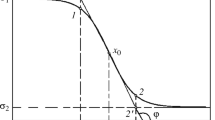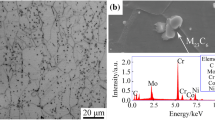Conclusions
-
1.
The electrical resistance of heat-resistant nickel alloys in the temperature range of dissolution of the γ′-phase is determined primarily by the volume share of γ′-phase and its specific electrical resistance. In dissolution of the γ′-phase the specific electrical resistance of the alloys drops.
-
2.
The temperature of the start of dissolution of the γ′-phase does not depend upon the change in content of the alloy elements and is 855±10°C. An increase in the alloy of the aluminum, titanium, and niobium contents leads to an increase in the temperature of complete dissolution of the γ′-phase, while a change in the chronium, cobalt, and molybdenum contents has practically no influence on it.
Similar content being viewed by others
Literature Cited
A. V. Logunov, N. V. Petrushin, and I. M. Khatsinskaya "The temperatures of dissolution of intermetallide phases in heat-resistant nickel alloys," Metalloved. Term. Obrab. Met., No. 6, 67–68 (1977).
A. V. Logunov, N. V. Petrushin, E. A. Kuleshova, and Yu. M. Dolzhanskii, "Prediction of the influence of structural factors on the mechanical properties of heat-resistant alloys," Metalloved. Term. Obrab. Met., No. 6, 16–20 (1981).
V. I. Ivernova and A. A. Katsnel'son, Short-Range Order in Solid Solutions [in Russian], Nauka, Moscow (1977).
N. F. Lashko, L. V. Zaslavskaya, M. N. Kozlova, et al., Physicochemical Analysis of Steels and Alloys [in Russian], Metallurgiya, Moscow (1978).
R. S. Mints, G. R. Belyaeva, and Yu. S. Malkov, "The interaction between the metallic compounds Ni3Al and Ni3Nb" Dokl. Akad. Nauk SSSR143, No. 4, 871 (1962).
C. L. Corey and B. Lisowsky, "Phase decomposition in near Ni3Al alloys" Trans. Met. Soc. AIME,239, No. 2, 233–248 (1967).
G. R. Stoeckinder and J. R. Neumann, J. Appl. Crystallogr.,3, No. 1, 32–38 (1970).
E. M. Greil', "An investigation of NiAl and Ni3Al," in: The Mechanical Properties of Metallic Compounds [in Russian], Metallurgiya, Moscow (1962).
I. G. Zedgenidze, Experiment Planning for Investigation of Multicomponent Systems [in Russian], Nauka, Moscow (1976).
V. G. Coates, Jr., "The deformation of heat-resistant alloys," in: The Superalloys, C. T. Sims and W. C. Hagel (eds.), Wiley (1972).
H. Fishmeister, "Forming of blades and powder metallurgy technology" in: Heat-Resistant Alloys for Gas Turbines. Materials of the International Conference [Russian translation], D. Kootsoradis, P. Felix, H. Fishmeister, et al. (eds.) Metallurgiya, Moscow (1981).
Additional information
Translated from Metallovedenie i Termicheskaya Obrabotka Metallov, No. 5, pp. 36–39, May, 1984.
Rights and permissions
About this article
Cite this article
Petrushin, N.V., Logunov, A.V. & Gorin, V.A. Structural stability of heat-resistant nickel alloys at high temperatures. Met Sci Heat Treat 26, 361–364 (1984). https://doi.org/10.1007/BF00707410
Issue Date:
DOI: https://doi.org/10.1007/BF00707410




